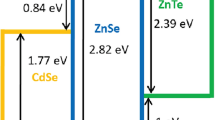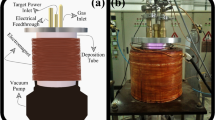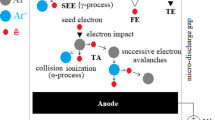Abstract
To better understand the plasma spray coating process, an experimental study of the interaction between a subsonic thermal plasma jet and injected nickel- aluminum particles was performed. The velocity, temperature, and composition of the argon/helium gas flow field was mapped using an enthalpy probe/mass spectrometer system. The sprayed particle flow field was examined by simultaneously measuring the size, velocity, and temperature of individual particles. Particle and gas temperatures were compared at the nominal substrate stand- off distance and axially along the median particle trajectory. Temperature and velocity differences between the particle and the gas surrounding it are shown to vary substantially depending on the trajectory of the particles. On the median trajectory, the average particle is transferring heat and momentum back to the plasma by the time it reaches the substrate. Because the exchange of heat and momentum is highly dependent on the particle residence time in the core of the plasma, the condition of particles at the substrate can be optimized by controlling the particle trajectory through the plasma.
Similar content being viewed by others
References
J. H. Zaat, A Quarter Century of Plasma Spraying,Ann. Rev. Mater. Sci., Vol 13, 1983, p 9–42
J. M. Houben, Future Developments in Thermal Spraying,Thermal Spray Coatings: New Materials, Processes and Applications, F.N. Longo, Ed., Am. Soc. for Metals, 1984, p 1–19
H. Fukanuma, An Analysis of the Porosity Producing Mechanism,Thermal Spray: International Advances in Coatings Technology, C.C. Berndt, Ed., ASM International, 1992, p 767–772
S. C. Snyder et al., Determination of Gas-Temperature and Velocity Profiles in an Argon Thermal-Plasma Jet by Laser-Light Scattering,Phys. Rev. E, Vol 47 (No.3), 1993, p 1996–2005
J.R. Fincke, R. Rodriguez, and C.G. Pentecost, Coherent Anti-Stokes Raman Spectroscopic Measurement of Air Entrainment in Argon Plasma Jets,Plasma Processing and Synthesis of Materials III, D. Apeilian and J. Szekely, Ed., Materials Research Society, Pittsburgh, 1990, p 184–191
J.R. Fincke, R. Rodriguez, and C.G. Pentecost, Measurement of Air Entrainment in Plasma Jets,Thermal Spray Research and Applications, T.F. Bernecki, Ed., ASM International, 1991, p 45–48
J. Grey, Thermodynamic Methods of High-Temperature Measurement,ISA Trans., Vol 4 (No. 2), 1965, p 102–115
S. Katta, J.A. Lewis, and W.H. Galvin, A Plasma Calorimetric Probe,Rev. Sci. Instr., Vol 44 (No. 10), 1973, p 1519–1523
J. Grey, P.F. Jacobs, and M.P. Sherman, Calorimetric Probe for the Measurement of Extremely High Temperatures,Rev. Sci. Instr., Vol 33 (No. 7), 1962, p 738–741
J.R. Fincke, S.C. Snyder, and W.D. Swank, Comparison of Enthalpy Probe and Laser Light Scattering Measurement of Thermal Plasma Temperatures and Velocities,Rev. Sci. Instr., Vol 64 (No. 23), 1993, p 711–718
W.L.T Chen, J. Heberlein, and E. Pfender, “Experimental Measurements of Plasma Properties for Miller SG-100 torch with Mach I Settings. Part 1: Enthalpy Probe Measurements,≓ Engineering Research Center for Plasma-Aided Manufacturing, University of Minnesota, Aug 1990
M. Brossa and E. Pfender, Probe Measurements in Thermal Plasma Jets,Plasma Chem. Plasma Process., Vol 8 (No. 1), 1988, p 75–90
A. Capetti and E. Pfender, Probe Measurements in Argon Plasma Jets Operated in Ambient Argon,Plasma Chem. Plasma Process., Vol 9 (No. 2), 1989, p 329–341
W. D. Swank, J.R. Fincke, and D.C. Haggard, Modular Enthalpy Probe and Gas Analyzer for Thermal Plasma Measurements,Rev. Sci. Instrum., Vol 64 (No. 1), 1993, p 56–62
J.R. Fincke, W.D. Swank, and C.L. Jeffery, Simultaneous Measurement of Particle Size, Temperature and Velocity in Thermal Plasmas,IEEE Trans. Plasma Sci., Vol 18 (No. 6), 1990, p 948–957
S. Gordon and B. McBride, “Computer Program for Calculation of Complex Chemical Equilibrium Compositions, Rocket Performance, Incident and Reflected Shocks, and Chapman-Jouguet Detonations,≓ NASA SP-273, Lewis Research Center, 1976
S.J. Kline and F.A. McClintock, Describing Uncertainties in Single-Sample Experiments,Mech. Eng., 1953, p 3–9.
R.N. Berglund and B.Y.H. Liu, Generation of Monodisperse Aerosol Standards,Env. Sci. Technol., Vol 7, 1973, p 147–152
A. Vardelle, M. Vardelle, P. Fauchais, P. Proulx, and M.I. Boulos, Loading Effect by Oxide Powders in DC Plasma Jets,Thermal Spray: International Advances in Coatings Technology, C.C. Berndt, Ed., ASM International, 1992, p 543–547
C.H. Chang, Numerical Simulation of Alumina Spraying in an Argon-Helium Plasma Jet,Thermal Spray: International Advances in Coatings Technology, C.C. Berndt, Ed., ASM International, 1992, p 793–798
Author information
Authors and Affiliations
Rights and permissions
About this article
Cite this article
Swank, W.D., Fincke, J.R. & Haggard, D.C. Behavior of Ni-Al particles in argon: Helium plasma jets. JTST 2, 243–249 (1993). https://doi.org/10.1007/BF02650472
Issue Date:
DOI: https://doi.org/10.1007/BF02650472




